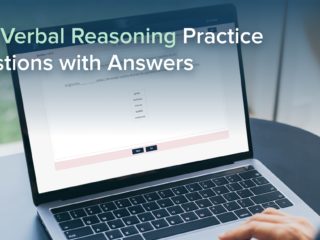| Getting your Trinity Audio player ready... |
Last Updated on January 12, 2024
As I like to say, algebra is the king of the GRE Quant section. I say this because algebra concepts appear in many question types, such as multiple-choice questions and Quantitative Comparison questions. Algebra is also a key tool that is used to solve many word problems.
In this article, we will cover some general rules involving algebra on the GRE, and then present a number of GRE math practice questions related to algebra.
Here are the topics we’ll cover:
- Linear Equations with One Variable
- Linear Equations with Two Variables
- Algebra Can Show Up Almost Anywhere in GRE Quant
- Algebra Example 1: General Word Problems – Two Variables
- Algebra Example 2: Exponents – One Variable
- Algebra Example 3: Work Problems – One Variable
- Algebra Example 4: Ratios – One Variable
- Algebra Example 5: Statistics – Two Variables
- Algebra Example 6: Geometry – Two Variables
- Algebra Example 7: Probability – Two Variables
- Algebra Example 8: Percents – One Variable
- In Summary
- Frequently Asked Questions (FAQ)
- What’s Next?
Before diving into GRE algebra practice questions, let’s cover some basics of how to deal with equations with one variable and simultaneous equations. We’ll start with how to deal with solving equations when we have just one variable.
Linear Equations with One Variable
In the GRE Quantitative Reasoning section, the most basic algebra questions contain just one variable. Your goal will generally be to solve for the value of the variable. For example:
- 2x + 5 = x
- 4 = 5n
- 2v + 5 = 3v – 7
It’s important to note that even if you see the same variable twice in a single equation, we are still working with a single-variable equation. As we will see in the next section, we combine the variables before solving.
TTP PRO TIP:
Even if a single equation has multiple occurrences of the same variable, it’s still a single-variable equation.
Let’s practice simplifying and solving an equation with one variable.
Solving a Linear Equation with One Variable
When we see a single-variable question in the GRE Quant section, we have one job: combine like terms and determine the value of the given variable. If done correctly, we will simplify the equation such that we end up with the variable isolated by itself, and it will be equal to a particular value. Let’s practice a basic example and explain the steps to solve it.
If 5n – 1 = 10n – 16, then what is the value of n?
Step 1: We can combine our non-variable terms.
So, we add 16 to both sides of the equation. Thus, we have:
5n – 1 + 16 = 10n – 16 + 16
5n + 15 = 10n
Step 2: We can combine variable terms.
So, we subtract 5n from both sides of the equation. Thus, we have:
5n + 15 – 5n = 10n -5n
15 = 5n
Step 3: Finally, divide both sides of the equation by 5 to isolate the variable. So, we have:
15 / 5 = 5n / 5
3 = n
KEY FACT:
When solving for a single variable, we combine like terms and isolate the variable we are solving for.
Now, let’s practice with an example.
Example 1: Linear Equation with One Variable
If 8x + 5 = 5x + 32, then x equals which of the following?
- 9
- 7
- 6
- 3
- 1
Solution:
Step 1: First, let’s combine the variable terms.
We can subtract 5x from both sides of the equation, giving us:
3x + 5 = 32
Step 2: Next, we combine the variable terms.
We can subtract 5 from both sides of the equation, giving us:
3x = 27
Step 3: Lastly, we divide both sides of the equation by 3, giving us:
x = 9
Answer: A
Next, let’s discuss equations with two variables.
Linear Equations with Two Variables
As you may expect, two-variable equations have not just one variable but two different variables. Let’s look at a few examples:
- v – u = 12
- 2x + y = 10
- 5z – 3y = 42
As we already discussed, these are two-variable equations because they contain two different variables. So, to solve these problems, we’d need a second equation that has one or both of the two variables. The two equations are called a system of linear equations. One popular way to solve for the values of the variables is by using the substitution method. So, let’s discuss the substitution method for solving a system of two linear equations.
Using the Substitution Method to Solve a System of Linear Equations
Everything we learned in the previous sections will help us solve a system of two linear equations.
When dealing with two equations, the essence of substitution is that we isolate one variable in one of the equations, and then substitute whatever that variable is equal to into the other equation.
If this sounds complicated, don’t worry—it’s not! Let’s practice with a couple of examples.
Substitution Method Practice 1
In the system of linear equations below, determine the value of m.
m = 3n (equation 1)
m + n = 12 (equation 2)
Solution:
Looking at our two equations, we see that m is already isolated in equation one. So, we can substitute 3n (from equation one) for m (in equation two). This gives us:
3n + n = 12
Now we can simplify and determine n:
4n = 12
n = 3
Substitution Method Practice 2
Using the system of linear equations below, what is the value of x?
5x + y = 14 (equation 1)
3x + 4y = 22 (equation 2)
Solution:
Unlike for the previous problem, we will have to do some work to isolate a variable. Looking at our equations, we can easily isolate y in equation 1.
Let’s do that below by subtracting 5x from both sides of the equation:
y = 14 – 5x
Next, we can substitute 14 – 5x for y in equation 2. This gives us:
3x + 4(14 – 5x) = 22
3x + 56 – 20x = 22
-17x = -34
x = 2
KEY FACT:
We can use the substitution method when solving a system of linear equations.
Next, let’s discuss the many topics on the GRE in which we see algebra problems.
Algebra Can Show Up Almost Anywhere in GRE Quant
Thus far, we have covered how to deal with algebra in one- and two-variable equations. Understanding the processes we’ve covered is very important because you’ll also need to use them when solving algebra in many more complicated and sometimes “wordy” GRE Quant topics:
- Exponents and Roots
- General Word Problems
- Rate Problems
- Work Problems
- Ratios
- Percents
- Overlapping Sets
- Combinations and Permutations
- Probability
- Geometry
- Coordinate Geometry
- Functions
- Sequences
As you can see, there are many Quant topics that require the use of algebra! The key when solving these problem types is first to use the various “topic-specific” rules to set up your equations, and then fall back on your algebra principles to solve for what the question asks for. If you are nervous, don’t be! We will practice with various algebra practice questions below.
TTP PRO TIP:
Be prepared to see algebra questions in many shapes and sizes.
Algebra Example 1: General Word Problems – Two Variables
Darius has 20 more coins than Rucker. If Darius and Rucker have a combined total of 38 coins, how many coins does Rucker have?
- 4
- 6
- 8
- 9
- 12
Solution:
Before creating our equations, we can define two variables:
We can let D = the number of coins Darius has and R = the number of coins Rucker has.
Next, we can create two equations:
Since Darius has 20 more coins than Rucker, we have:
D = R + 20 (equation 1)
Since Darius and Rucker have a combined total of 38 coins, we have:
D + R = 38 (equation 2)
Since we have D isolated in equation 1, we can substitute R + 20 for D in equation 2, and we have:
R + 20 + R = 38
2R + 20 = 38
2R = 18
R = 9
Rucker has 9 coins.
Answer: D
Next, let’s see how algebra can be presented in an exponent question.
Algebra Example 2: Exponents – One Variable
If (3^4x)(27^4) = (81^3x), then x is equal to which of the following?
- 1.5
- 2
- 3
- 3.5
- 4
Solution:
We first simplify each base into prime factors. The current bases are 3, 27, and 81. Since 3 is prime number, it is already simplified, so we need only simplify the other two bases:
27^4 = (3^3)^4 = 3^12
81^3x = (3^4)^3x = 3^12x
The original equation can now be re-expressed as:
(3^4x)(3^12) = 3^12x
3^(4x + 12) = 3^12x
Dropping the bases and equating the exponents, we can solve for the value of x:
4x + 12 = 12x
12 = 8x
12/8 = x
3/2 = 1.5 = x
Answer: A
Algebra Example 3: Work Problems – One Variable
Working at a constant rate, Felix can complete a job in 4 hours, and his father, when working at a constant rate, can complete the same job in 5 hours. Working together at their same constant rates, how long will it take Felix and his father to complete the job?
- 2
- 20/9
- 3
- 24/9
- 4
Solution:
Since Felix can complete a job in 4 hours, his rate is 1/4.
Since his father can complete the same job in 5 hours, his rate is 1/5.
Since they are working together to complete the job, we can let the time they work together = t.
Thus, the work done by Felix is t/4, and the work done by his father is t/5.
Next, we can use the combined work formula to solve for t.
Work of Felix + Work of Father = 1
t/4 + t/5 = 1
Multiplying both sides of the equation by 20, we are left with:
5t + 4t = 20
9t = 20
t = 20/9 hours
Answer: B
Algebra Example 4: Ratios – One Variable
A box contains only blue pens, black pens, and red pens. If the ratio of blue pens to black pens to red pens is 2 to 5 to 8, and if there are 24 more red pens than blue pens, how many black pens are in the box?
- 8
- 15
- 20
- 24
- 30
Solution:
First, we can express the ratio using the ratio multiplier.
blue : black : red = 2x : 5x : 8x
Since there are 24 more red pens than blue pens, we have:
8x – 2x = 24
6x = 24
x = 4
The number of black pens is 5x. Thus, the correct answer is 5 * 4 = 20 black pens.
Answer: C
Algebra Example 5: Statistics – Two Variables
A particular data point of 12.5 was 1.5 standard deviations above the mean, and another data point of 4.5 was 2.5 standard deviations below the mean. What is the mean of the data set?
- 5
- 6.5
- 7.5
- 8
- 9.5
Solution:
We can let m = the mean and d = the standard deviation. Now let’s create our equations:
Since 12.5 was 1.5 standard deviations above the mean, we have:
12.5 = 1.5d + m
m = 12.5 – 1.5d (equation 1)
Since 4.5 was 2.5 standard deviations below the mean, we have:
4.5 = m – 2.5d (equation 2)
Next, we substitute 12.5 – 1.5d from equation 1 for m in equation 2, giving us:
4.5 = 12.5 – 1.5d – 2.5d
4d = 8
d = 2
Finally, we can find the mean as follows:
m = 12.5 – 1.5(2)
m = 12.5 – 3
m = 9.5
Answer: E
Algebra Example 6: Geometry – Two Variables
If lines a and b are parallel, what is the value of y?
- 30
- 45
- 50
- 60
- 65
Solution:
Since we have two parallel lines and a transversal, we can create the following two equations:
x + 60 = 2x
60 = x
and
2x + 2y = 180
x + y = 90
Since 60 = x, we now have:
60 + y = 90
y = 30
Answer: A
Algebra Example 7: Probability – Two Variables
A carnival stand has only pink cotton candy and red cotton candy. The probability of selecting a pink cotton candy is 1/5. If there are 12 more red cotton candies than pink cotton candies, how many red cotton candies are at the stand?
- 4
- 8
- 12
- 16
- 18
Solution:
We can let the number of pink cotton candies = p and the number of red cotton candies = r.
Since the probability of selecting a pink cotton candy is 1/5, we have:
p / (p+r) = 1/5
5p = p + r
4p = r (equation 1)
Next, since there are 12 more red cotton candies than pink cotton candies, we have:
r = p + 12 (equation 2)
From equation 1, we know that 4p = r . So, we substitute 4p for r in equation 2. This gives us:
4p = p + 12
3p = 12
p = 4
We substitute 4 for p in equation 2:
r = 4 + 12
r = 16
Answer: D
Algebra Example 8: Percents – One Variable
The price of a certain television was marked down 50 percent. Because it still had not sold, the price was eventually marked down another 25 percent before selling for $600. What was the original price of the television?
- $1,400
- $1,600
- $1,700
- $1,800
- $2,000
Solution:
We can let the initial price of the TV = p.
After being marked down 50%, the new price is 0.50p.
Ater being marked down an additional 25%, the new price is 0.75 * 0.50p = 0.375p.
Since the final price is $600, we can create the following equation and use it to determine p:
0.375p = 600
375p = 600,000
p = 1,600
Answer: B
In Summary
Having great algebra skills is paramount for earning a good GRE score! Algebra is tested in a variety of question types, so mastering basic algebra is critical.
In this article, we presented two fundamental algebra problems to teach the basic skills for solving equations when we have (1) a linear equation with one variable or (2) a system of two linear equations. Mastery of these two equation-solving techniques will help you solve a variety of GRE math questions, including general word problems, exponents, work, ratios, statistics, geometry, probability, and percents.
Clearly, solid knowledge and understanding of algebra is crucial for getting a high GRE score.
Frequently Asked Questions (FAQ)
Is There Algebra on the GRE?
As you have seen in this article, the GRE is littered with algebra!
How Many Algebra Questions Are on the GRE?
Algebra can pop up in many different problem types on the GRE. So, there is a very real chance that you could have to use algebra in as many as 20 of the 27 Quant questions on the GRE.
What Is the Most Popular Math Question on the GRE?
Because algebra is so important in so many questions, I would say algebra is the most important math skill you must have for GRE quant.
How Can I Improve My GRE Algebra Skills?
When thinking about how to improve your GRE algebra skills, it’s important to realize that you must walk before you run. In other words, make sure you first learn how to deal with single-variable equations and simultaneous solution of equations before using those skills in the context of word problems. Learning in this way will make you an ace when solving algebra questions on the GRE.
You can find some additional study tips in our article about the best way to study for the GRE.
What’s Next?
I hope that you walk away from this article with a much better understanding of how to deal with algebra questions on the GRE. However, if you need some more help with GRE Quant, I welcome you to check out our article providing the top 10 tips for a top GRE Quant score. And if you want some additional algebra practice, check out the 5-day trial of our GRE self-study course



